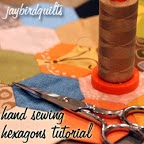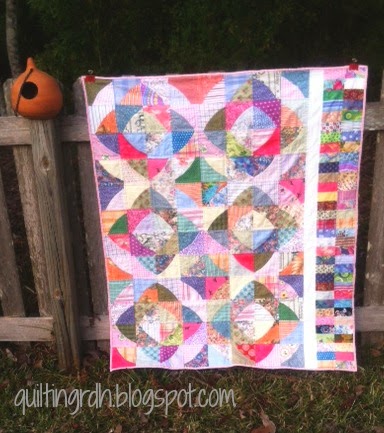I had a nice lady named Amy contact me about a pattern for the hexagon stars quilt I have been working on. Its not quite finished, but I think I have enough to make a good start.
 |
| Not sewn together yet. |
Hexagons are a great take-a-long project. I take them to work on at lunch, doctor appointments and road trips. I even look forward to getting my oil changed- that's usually a solid hour of uninterrupted sewing!
*To see a little of the history of this quilt go to the "hexies" tab at the top on the page.
Disclaimer: I am not an expert on hexagon quilts. I just saw one I liked and did some research on the internet and have spent many hours and made some mistakes and have a pretty good idea of how it works now. My goal is to save someone else time and aggrevation and some money.
If you already have a preferred way of making hexies, you can skip this part. The following is the easiest and least expensive way I have found.
I purchased a Creative Memories punch on EBay. Of course by the time I decided that I needed one, they had been discontinued. So after watching most of the bids climb to an outragous price, I snagged one for a decent price and then Fiskars came out with 3 different readily available sizes of hexagon punches.
Go figure.
*I like the Creative Memories one a little better- it seems more sturdy- but any punch you can find will do.
 |
| The punch on the right gives you a 1.5 inch across and 3/4 inch sides. |
Instead of punching regular printer-weight paper and sewing through it, I punch out cereal or cracker boxes and use a regular offiice hole punch to put a hole in the center of each one.
Here's a link to a great tutorial over at Jaybird Quilts on how to sew hexies. There are three steps, but you'll only need the first two for this quilt. While you're there, check out some of her other tutorials- Julie has her own collection of templates and rulers and is quite talented!
So I do mine pretty much like that except I use the cardboard boxes. I also put the rough side of the cardboard against the back of the fabric because it seems to keep it from sliding around.
For thread, I use hand quilting thread. I keep white and light tan/neutral handy. Unless you are sewing very dark fabric, the light tan/ neutral works great for most colors. Use white thread if you're using bright white fabric for the background.
Also, get yourself a thimble. I have never been able to wear a thimble until I started this quilt. The tip of my middle finger got a hole in it, so I learned to use it pretty fast. I love the jelly thimbles and found mine at Hobby Lobby.
Fabric Requirements
For the white or background hexies you will need 1747 which comes to about 5 yards- get 5 1/2 to be safe. I just used the mid priced muslin.
You will need 126 centers, so a 1/2 yard of 44 inch fabric will be plenty. I used yellow centers, but i think you could use any color as long as they were all the same. Just remember to use a color that you won't be using too many others places in the quilt.
I cut my fabric into 2 inch strips then about 2 inch squares. The square doesn't have to be exact, I just slide a cardboard hexie down the strip for a reference and cut as I go. Trim the corners to about 1/4 inch.
For all of the other colors, I just grabbed strips out of my 2 inch strip bin. You will need 2 inches of strip per hexie. For example, if you need 6 hexies, you will use a 12 inch strip, 18 hexies will require 36 inches.
There aren't any rules for fabric selection, except use decent 100% cotton that isn't too thick (like decorator fabric) and be positive that it will not bleed. You will spend a lot of time on this quilt and you want it to last.
I made some of my circles and stars matchy, some I went with contrasting fabrics like purple and green or blue and yellow.
Start with the center hexie and add one from the inner ring.
Keep sewing until you have a flower. If you are using directional prints, you might want to pay attention to the placement. If I thought about it when I was sewing them, I tried to make them symmetrical. If you forget, that's OK too, they still turn out fine and you hardly notice in such a big quilt.
Continue with the next ring.
Then add your background ring.
The stars start out the same way.
 |
| Sew all the way around to complete the circle on the top. |
Make a center with two rings. The next ring will alternate two inner points, and one point edge.
Make the points separately using five edges and one inner point.
Connect the points to the main body to complete the star.
When you're making a half star, start with the inner ring and outer ring then alternate two inner points an one point edge, but stop when you have this:
Leave off the last 4 hexies on the top.
 |
| Make three |
 |
| Make two |
Make three points out of six hexies and two small triangles.
Now add them to the main body like this. Then add 10 white hexies to the straight edge.
For the circles, you need:
1 center
6 inner ring
12 outer ring
18 white
For the stars you will need:
1 center
6 inner
12 outer
18 inner triangles
36 point edges
For the half stars you will need:
1 center
6 inner
12 outer
15 inner triangles
23 point edges
10 white
Each three patch is made of 3 colored hexies and 3 white.
Each 4 patch is made of 4 colored hexies and 12 white.
Don't let the numbers scare you- it is not a race. I've been working on mine for almost 4 years and I can anticipate another year easy.
When you sew the hexies together, it starts out pretty easy. But once you get to the second ring on the circles, it really matters what direction you go. Like how when you're sewing on a machine, its easier to sew with the bulk of the fabric on the left and not all bunched up under the arm. If you start having trouble handling your sewing, try turning it the other way. It sounds confusing, but you'll understand when you get to that point.
 |
DO NOT pop out any cardboard hexies until they are completely surrounded. Its easier to sew when you still have the cardboard in there. So when you're finished with a circle you can pop out all of the inner hexies and just leave in the edges- same with the stars.
 |
| I use those containers that Crystal Light comes in hold hexies in progress. |
Once you get all of the parts finished and you're ready to sew them together, arrange them how you like and take lots of pictures. This is where the camera on your cell comes in handy. Also, you might need a ladder to get it all in one shot.
Sew the pieces together just like you sew the hexies together, match the edges up to one another and use a slip stitch on the back.
The photo above shows three columns and one half column already sewn together. The other half column is on the ground.
Here's a better picture of it.
I found it easier to sew half a column at a time, then sew all the columns together. Honestly, this is the hardest part, especially on such a large project. Find a comfy spot with a TV and just get to it- do not be discouraged.
* Remember, you can pop it the cardboard pieces as you go as long as they are surrounded. In the end, you should have the entire quilt with just the edges that still have the cardboard.
Here's one more tip -when you're ready to add a half column, lay it out facing up and use a needle and thread to tack it to the main quilt every 4-5 hexies. This makes it easier to handle when sewing the larger pieces together. I used red thread in the above picture to make it easier to see.
If you find this tutorial helpful, or if you have questions, or find errors (please be kind) or if you just want to share what you're working on, I'd love to hear from you!




























